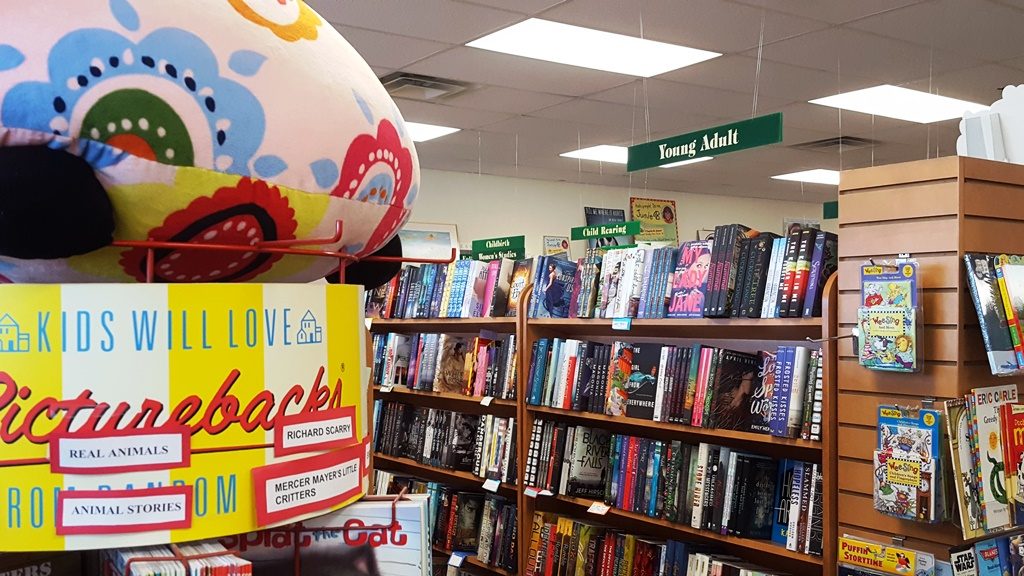At the Bookstore – Children’s Literature Posted by Gary Locke on Sep 2, 2016 in Culture, English Vocabulary

Browse through the Children’s Literature section of your bookstore.
If you are looking for a specific book, or even just something you’d like to read, it helps to know the various categories that bookstores use for shelving their products.
Almost every store has three main categories of books in different locations on the sales floor – Nonfiction, Fiction, and Children’s. You will then find those sections of the bookstore divided into sub-categories, and then within those sub-categories will be more specific micro-categories. Many visitors to a bookstore always head to one part of the store, knowing that the books they usually like to read are in that area. We have already journeyed down the various aisles of the Nonfiction and Fiction sections. Now, let’s browse through the Children’s Literature shelves, as well as some of the other sections you should expect to see in the bookstore.
Children’s Literature
Because kids read on very different levels, there is a lot of crossover in these categories. Age groups are just a general guide. I always suggest talking to your salesperson about the books that the child has read and enjoyed, in order to make the right selection.
Activity and Board Books – Sometimes these categories are one and the same. Activity books are interactive, and are intended to both challenge and entertain children, particularly first grade and younger. These books generally contain puzzles and games, pictures to color, and mazes. Board books are for very young children, and are distinguished by the heavy paperboard they are printed on, which makes them more durable and almost impossible to tear. These are often called first books, and can introduce your youngest to the basics in speech, nature, and the world around them. As you read these to your children, expect simple rhymes and bright, colorful pages. You’ll memorize them quickly.
Picture Books – This category comprises illustrated stories often thought of as bedtime stories. Most of the books in this category begin as stories that a parent reads to a child, eventually transitioning to one which the child learns to read on their own. Goodnight Moon, by Margret Wise Brown and Clement Hurd, and any of the books of Dr. Seuss, are perennial classics.
Folk and Fairy Tales – Don’t be surprised if your bookshop has further divided this category into age groups. Folk tales teach culture and history in a very entertaining way, and are often the first real stories that anyone reads. Tomie dePaola is a brilliant author and illustrator with scores of books to his credit in this category.
Juvenile Fiction – At what age does a young person transition to the books in this category? Only the child knows for sure. However, probably somewhere between the ages of nine and thirteen these books will trigger a young reader’s imagination. And, if you’re lucky, they will never stop reading. Overwhelmingly, the most treasured author in this category in modern time is J.K. Rowling and her tales of the young wizard, Harry Potter. Not to be overlooked are Anne of Green Gables, by L.M. Montgomery and, of course, Harper Lee’s monumental American classic, To Kill a Mockingbird.
Juvenile Nonfiction – Here’s a category which encompasses all the various categories in Nonfiction for adults, but for younger readers. You’ll select from Biographies, Memoirs, History, Self-Help, Science, and Education. At some point your child will have questions, and they won’t want the answers from you. This is where you’ll point them for guidance when the eye-rolls begin. One book in this category stands head and shoulders above all others, though, and that is The Diary of a Young Girl, by Anne Frank.
You’ll also find in many bookstores a selection of:
Audio Books – Many of the books on the shelves are available in recorded form, often narrated by the authors themselves (John Le Carré is especially good). You’ll find abridged versions, or the complete work. Sometimes these recordings are elaborate productions, with multiple layers of music, sound effects, and famous actors as readers. Patrick Stewart’s recording of A Christmas Carol is an absolute treasure.
Bookmarks – A true book lover would never turn their books upside down for hours at a time, or bend back the pages. You need a bookmark to indicate where you left off, and especially one which reflects your personality. You’ll be amazed at the choices available!
Journals – Sometimes you want to record your own thoughts for posterity, and a handsome journal is just the thing. These are often leather-bound, and make a wonderful gift.
Booklights – These little bright lights clip onto a book, and are great for reading in bed when the person next to you wants to sleep. In my house, these are sometimes known as the marriage saver.
Greeting Cards – Most bookstores offer beautiful and unique cards for all occasions.
Calendars – Offered in almost as many categories as books, a bookstore is the best place to find beautiful calendars.
Remainders – When a publisher has too much stock of a book, after it has been on sale for a while, they sell the remaining copies to bookstores for a greatly reduced price. Looking for a bargain? Ask the staff of your bookshop where they put their remainders.
Our tour of the bookstore is now complete. But, the adventures inside never end.

Build vocabulary, practice pronunciation, and more with Transparent Language Online. Available anytime, anywhere, on any device.




Comments:
Nico:
My top picture books:
1) Love You Forever by Robert Munsch
2) The Polar Express by Chris Van Allsburg
3) Where the Wild Things Are by Maurice Sendak